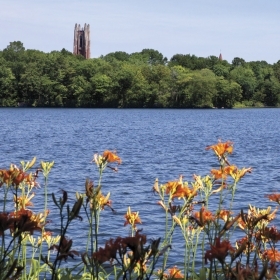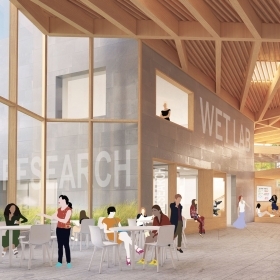It’s all about power. How we produce it, how much we use, and how much we waste.
These issues were at the heart of the work the College’s Power4Women task force did for a year. Composed of trustees, faculty, staff, and students, the task force looked at how to best meet Wellesley’s energy needs while also working toward the goals of the sustainability plan adopted in 2016. The group’s work was already critical, but it became even more urgent after the College’s 24-year-old cogeneration plant failed this past summer.
“We knew that the cogeneration power plant was on its last legs and was way past its useful life,” says Piper Orton, vice president of finance and administration, and treasurer. “We needed to put in place a plan to ensure the electricity, heating, and cooling supply of the College.”
That plan was announced this past October, as the College committed to a three-year, $24 million energy initiative that will not only keep the lights on, but also reduce the College’s energy consumption and carbon footprint.
The initiative will start with conservation measures—206 of them, in fact. “We’re going to invest $6 million in energy-conservation measures, and we expect to reduce electricity consumption by 18 percent and thermal energy consumption by 6 percent,” says Dave Chakraborty, assistant vice president for facilities management and planning. These measures range from sealing windows to adding sensors for automatic light control.
The remaining $18 million will be spent on the plants that keep the College running. The cogeneration plant will be dismantled, and a new peak-shaving power plant will be installed. Previously, the cogeneration plant created almost all of the College’s electricity from its natural-gas-fired engines. Once the new plant is installed, it will only generate electricity during peak usage or a failure of the town’s system. “The plant is designed to run 600 hours [a year], but we don’t expect it to run for that much,” Chakraborty says. “If there is a failure in the grid for, say, a snowstorm, we can then run our own generators. … It gives us resiliency.”
And generating its own electricity during peak demand keeps the College on a lower rate all year long. “That will essentially cut our rate for electricity … about in half,” Orton says.
The current steam-absorption chiller plant for the air-conditioning systems will be replaced with an all-electric plant, and the boilers for the heating system will be refurbished to extend their lives by 10 to 15 years. “We didn’t want to have a system or a design that locked us into any one strategy for a long period of time,” says Lawry Jones Meister ’83, trustee and chair of the Power4Women task force. “We know that the world is changing really quickly, and we want to keep a degree of flexibility.” The College will pursue discussions with potential partners to increase production of energy from renewable sources, such as wind and solar power.
This initiative is just the beginning of the College’s work toward its ultimate goal of carbon neutrality. These first steps will reduce the College’s greenhouse-gas emissions by 37 percent compared with the 2010 baseline and reduce utility costs by roughly 10 percent.
The next stage in meeting the goals of the 2016 sustainability plan now falls to a new task force, E2040. “We have many more steps to take to keep moving this forward,” Orton says. “We want people to see this $24 million not as an end point, but as a starting point.”








We ask that those who engage in Wellesley magazine's online community act with honesty, integrity, and respect. (Remember the honor code, alums?) We reserve the right to remove comments by impersonators or comments that are not civil and relevant to the subject at hand. By posting here, you are permitting Wellesley magazine to edit and republish your comment in all media. Please remember that all posts are public.